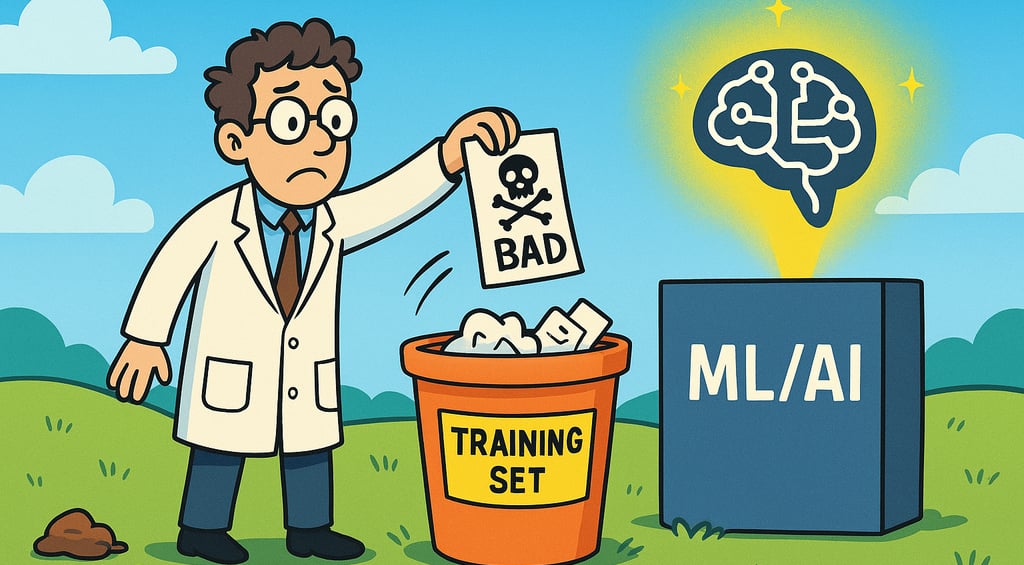Accelerate your protein engineering. Download our free guide to cell display
How NOT to Build a High-Quality Dataset for AI Protein Engineering: A Guide to Failure
This satirical guide outlines the fastest way to sabotage an AI protein engineering project by detailing how to build a deliberately flawed dataset. By humorously encouraging researchers to avoid replicates, limit diversity, and embrace inconsistency, the article highlights the most common and costly pitfalls in data collection for biologics development. Ultimately, this "guide to failure" serves as a memorable lesson on the critical importance of rigorous, high-quality data and expert partnership.
10/21/20253 min read


So, you've decided to venture into the world of AI protein engineering. You've heard the promises of predictive design and accelerated biologics development, but perhaps you're more interested in generating impressive-looking models that are confidently and spectacularly wrong. You've come to the right place.
The fastest way to ensure your AI protein engineering project produces useless results is to sabotage it from the start with a poorly constructed dataset. After all, the most advanced algorithm on the planet is no match for a foundation of noisy, biased, and inconsistent data. This is your definitive guide to ensuring your model learns nothing of value. Welcome to the art of "Garbage In, Garbage Out."
Rule 1: Embrace the Noise - Accuracy is a Guideline, Not a Rule
The first step to building a useless dataset is to treat your experimental measurements with a healthy dose of skepticism. Precision is for pessimists.
Avoid Replicates: Running biological replicates is time-consuming and often reveals the inconvenient truth of experimental variability. Stick to a single measurement (n=1). It’s cleaner, faster, and gives your model a false sense of confidence.
Always Average Your Data: If you absolutely must run replicates, make sure to average them into a single number before giving them to the model. Better yet, if one replicate looks much better than the others, just use that one. The model loves a clean, simple (and completely misleading) data point. Never provide the raw data; that would allow the model to learn about the assay's natural error, and we can't have that.
Rule 2: Stick to What You Know - Diversity is Overrated
The goal is to build a model that is an expert in a very, very small corner of sequence space. The best way to do this is to limit its exposure to new ideas.
Only Include Your Greatest Hits: Why would you confuse the model by showing it what doesn't work? Only include data from your best-performing variants. Negative data is for naysayers and will only teach the model what not to do, which is counterproductive to our goal of getting confidently wrong predictions.
Keep Your Mutations Conservative: Don't bother exploring diverse sequence space. Stick to single-point mutations in the one CDR loop you already know is important. This ensures your model will be completely blind to any potentially better solutions elsewhere in the protein.
Rule 3: Keep It Interesting - The Virtue of Inconsistency
A model trained on consistent data will learn consistent rules. To avoid this, you must introduce as much "variety" as possible into your experimental conditions.
Change Your Protocol Freely: Did you change the buffer composition between Batch 1 and Batch 2? Use a different cell passage number? A different technician? Excellent. This unlabeled variation adds a layer of exciting unpredictability that will prevent the model from learning any real sequence-function relationships.
Mix and Match Assays: Have data from three different binding assays run on different instruments? Combine it all into one glorious dataset. Don't bother labeling which data point came from which assay. The model will surely figure it out.
Rule 4: Trust Your Gut - Process Data Aggressively
Raw data is messy and untamed. Before you give it to your model, you need to shape it into something more presentable.
Normalize Everything: Never provide raw measurements. "Fold-change over wild-type" sounds much more scientific and impressive. The model doesn't need the context of the baseline; it just needs to know which numbers are bigger.
Embrace Pooled Data: To save time, be sure to pool several different variants together and take a single measurement. It’s far more efficient, and you can trust the model to correctly assign the functional score to the one true hit among the 50 variants in the pool. This is a fantastic way to ensure the genotype-phenotype link is hopelessly broken.
Conclusion: From Misdirection to Meaningful Results
While this guide has highlighted what can go wrong, the reality is that building a high-quality dataset for AI protein engineering requires deep expertise and rigorous execution. Navigating these pitfalls is a significant challenge in modern biologics development, and getting it right is the difference between a failed project and a successful discovery.
To avoid these common traps, partnering with an experienced team is essential. Contact Ranomics to learn how our protein engineering services can help you build the robust, high-quality datasets needed to drive your discovery pipeline forward.
Get in touch
Are you looking to build a custom AI dataset for your next protein engineering project?
Come chat with our experts
